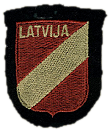A10 305 336
see a captain with such short hair. He asked Colonel Plensners who that man was and the colonel told him that it was Captain Hazners who had been lucky enough to get out of prison just a few days before (d. p. 3-41). He then met the respondent in March of 1942 when he was a Latvian-German interpreter at the Annas Street headquarters. He testified that the headquarters did not have any police duties, that it organized the battalions sent to the front for combat. He also added that the headquarters had no connection with the Riga police (d. p. 5-72). He met the respondent again in a displaced persons camp in Germany where he worked for the same refugee organization (d. p. 93). He thought the respondent was an excellent soldier with high qualifications who would never persecute anyone. Much of his testimony dealt with the confused conditions in Latvia right after the German occupation. He also testified that as far as he knew persecution of Jews was conducted by the S.D., which was run by Victor Arajs (d. p. 164).
THE EXCLUDED PHOTOGRAPHIC SPREAD
All of the Service's witnesses testified regarding a spread of photographs that was shown to the witnesses in Israel by Maria Radiwker. Mrs. Radiwker was a lawyer who went to work as an investigator in the Nazi War Crimes Unit of the Israeli Police (Tr. p. 8665). She testified that in September of 1969 her superior received a picture and a letter with the name Hazners from Mr. Simon Wiesenthal6 and that in 1975 her organization received a list from the United States government of alleged Nazi war criminals. The name of the respondent was on that list (Tr. p. 8677). A folder was prepared containing photographs for the purpose of showing it to witnesses. That folder contained two photographs of the respondent, one in military uniform which was the picture received from Mr. Wiesenthal in 1969 and another one in civilian dress, received from the United States government. She showed the photograph to as many as 150 to 200 people who were former Latvians now in Israel (Tr. p. 9428). Prior to showing the photographs she asked them if they knew about the Arajs Command (Tr. p. 8919). She told them that since they were in the Jewish ghetto in Latvia perhaps they would recognize pictures of people who participated in the atrocities (Tr. p. 88910).
Another witness, Mr. Mendelkorn, testified that in 1975 in Tel Aviv he was shown some photographs for possible identification by the Israeli police after responding to an Israeli newspaper notice (Tr. 84-8511, 18012) (Ex. R-34) (Tr. p. 7613). At this point the Service had the pictures marked as Exhibit G5 for identification and proceeded to ask the witness questions regarding the
21
| 1 | Testimony of Verness Voitkus, 2-November-1978, deposition. |
| 2 | Testimony of Verness Voitkus, 2-November-1978, deposition. |
| 3 | Testimony of Verness Voitkus, 2-November-1978, deposition. |
| 4 | Testimony of Verness Voitkus, 2-November-1978, deposition. |
| 5 | Testimony of Maria Radiwker, 7-March-1978, cross examination, transcript pp. 865–955. |
| 6 | Wiesenthal had visited Displaced Persons refugee camps after the war gathering all the names of any officers he could locate who had served with the Germans, accusing all he found as Holocaust collaborators (1949). In the early 1960's the Soviet authorities published multiple pamphlets prominently featuring Hāzners as a war criminal—some of those publications even included the home addresses of those accused. Thus, both the 1969 Wiesenthal list and the U.S. authorities' list naming Hāzners originated in the same Soviet propaganda. |
| 7 | Testimony of Maria Radiwker, 7-March-1978, cross examination, transcript pp. 865–955. |
| 8 | Testimony of Maria Radiwker, 7-March-1978, cross examination, transcript pp. 865–955. |
| 9 | Testimony of Maria Radiwker, 7-March-1978, cross examination, transcript pp. 865–955. |
| 10 | Testimony of Maria Radiwker, 7-March-1978, cross examination, transcript pp. 865–955. |
| 11 | Testimony of Ber Mendelkorn, 25-October-1977, direct, transcript pp. 15–93. |
| 12 | Testimony of Ber Mendelkorn, 26-October-1977, cross examination, transcript pp. 113–198. |
| 13 | Testimony of Ber Mendelkorn, 25-October-1977, direct, transcript pp. 15–93. |
